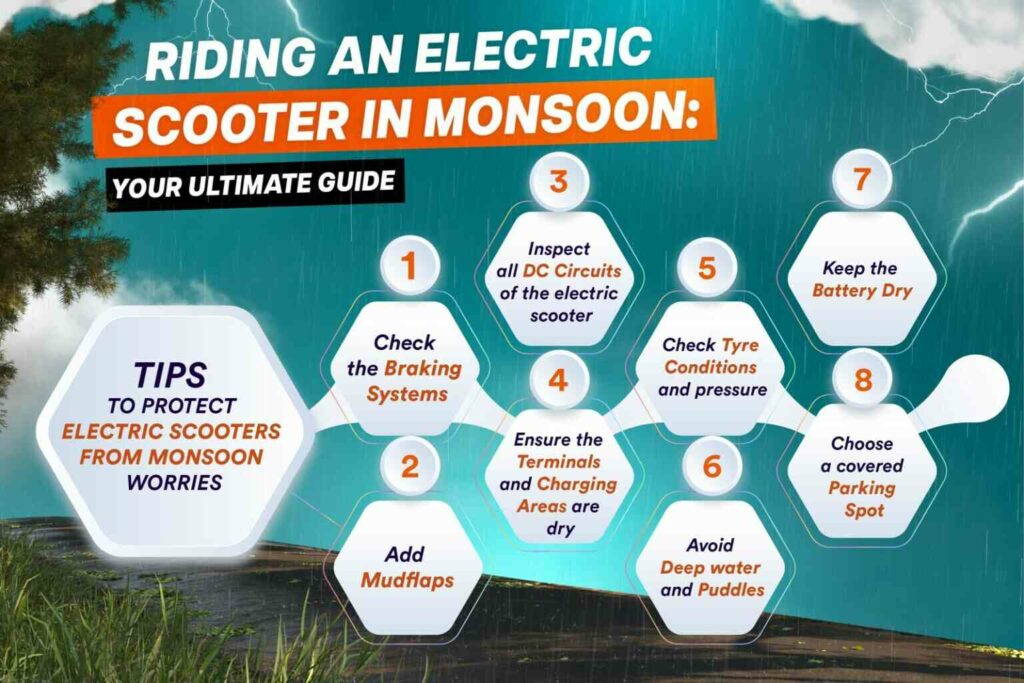
Electric Scooter Safety Tips During Monsoon
Riding an electric scooter in Monsoon opens up a world of possibilities, but it also comes with its challenges. This ultimate guide will not only cover the precautions you need to take when navigating through monsoon rains but also address what to do if your electric scooter gets wet and the safety of charging during the rain.
What Are the Precautions to Follow When Riding an Electric Scooter in Monsoon?
Riding an electric scooter in Monsoon requires a blend of caution and preparedness. Here are essential precautions to keep in mind:
Check Tyre Tread for Optimal Grip:
Riding on wet roads demands proper traction. Ensure your scooter’s tyres have sufficient tread depth for optimal grip even during rainy day electric scooter riding.
Inspect Braking Systems Regularly:
Wet conditions amplify the importance of efficient brakes. Regularly check brake pads and discs to maintain reliable stopping power, especially during wet road electric scooter handling.
Adjust Speed and Maintain Safe Distance:
Lower your speed and maintain a safe following distance to prevent accidents, considering riding safely in wet conditions.
Wear Appropriate Gear for Safety:
Donning protective gear is crucial. A helmet, gloves, and a waterproof jacket will enhance your safety and visibility, helping in Monsoon scooter gear.
Avoid Puddles and Deep Water:
Steer clear of puddles and deep water on the road to prevent water from entering critical components, ensuring electric scooter water safety.
Regular Maintenance Checks for Your Electric Vehicle:
Conduct routine checks on your electric scooter. Ensure lights, indicators, and brakes are in top condition for Monsoon scooter maintenance.
What Should I Do if My Electric Scooter Gets Wet During Monsoon?
Despite precautions, your electric scooter may encounter rain. Here’s a step-by-step guide on what to do:
- Inspect the Battery Compartment: Check for signs of water ingress. Remove the battery and dry the compartment thoroughly to prevent electric scooter water protection issues.
- Dry the Electrical Components: Wipe down exposed electrical components with a dry cloth to prevent water damage. Accelerate drying to avoid electric scooter water resistance problems.
- Check for Corrosion: Address any corrosion promptly to maintain electrical conductivity and ensure electric scooters in the rain safety.
- Air Dry the Scooter: Allow your electric scooter to air dry in a covered area to prevent issues with Monsoon electric scooter maintenance. Avoid using direct heat sources, as excessive heat can harm electrical components.
Is It Safe to Charge an Electric Scooter in the Rain?
Charging your electric scooter in the rain can be safe with these precautions:
- Use Covered Charging Stations: Opt for covered charging stations whenever possible to shield both yourself and the scooter from direct rain exposure, ensuring electric scooter water protection during charging.
- Ensure Dry Connection Before Charging: Make sure both the charging pin and socket are dry to prevent malfunctions or delays, supporting rain-resistant electric scooter features.
- Invest in a Waterproof Cover: Consider using a waterproof cover designed for electric scooters during charging. It adds an extra layer of protection against moisture, supporting electric scooter water resistance.

Tips to Protect Electric Scooters From Monsoon Worries
Now, let’s explore specific tips to safeguard your electric scooter during the monsoon:
- Check the Braking Systems: Regularly inspect your scooter’s brake pads and discs for wear. Wet conditions demand optimal braking efficiency, necessitating wet weather electric scooter tips.
- Add Mudflaps:
Mudflaps safeguard against splashes and mud, providing enhanced undercarriage protection during monsoon scooter commuting. - Inspect all DC Circuits:
Examine all DC circuits for signs of corrosion or water ingress. Apply a water-resistant coating for added protection, essential for Monsoon electric scooter maintenance. - Ensure Dry Terminals and Charging Areas:
Regularly check and clean battery terminals to prevent corrosion. Designate a covered area for charging to safeguard against rain and ensure electric scooter water protection. - Avoid Driving in Slippery Areas:
Exercise caution in slippery areas, such as painted road markings. Reduce speed and maintain a safe following distance to prevent accidents, crucial for riding in the rain with an electric scooter. - Check Tyre Conditions and Pressure:
Monitor tyre tread depth and maintain optimal pressure. Properly inflated tyres ensure better traction on wet surfaces, which is essential for electric scooter water safety. - Avoid Deep Water and Puddles:
Steer clear of deep water and large puddles to Prevent water from entering critical components by avoiding deep water, which is crucial for riding in the rain with an electric scooter. - Keep the Battery Dry:
Inspect the battery housing regularly for signs of water entry. Consider using a battery cover for additional protection, aiding electric scooter water safety. - Choose a Covered Parking Spot:
Whenever possible, park your Electric bike in covered areas to shield your electric scooter from direct rainfall, supporting Monsoon electric scooter safety.
By incorporating these precautions and tips into your monsoon riding routine with an electric scooter, you can confidently enjoy your ride, ensuring both safety and longevity in the face of challenging weather conditions.
Stay safe, stay dry, and embrace the thrill of riding in the monsoon with our best range of electric scooters from Komaki!


